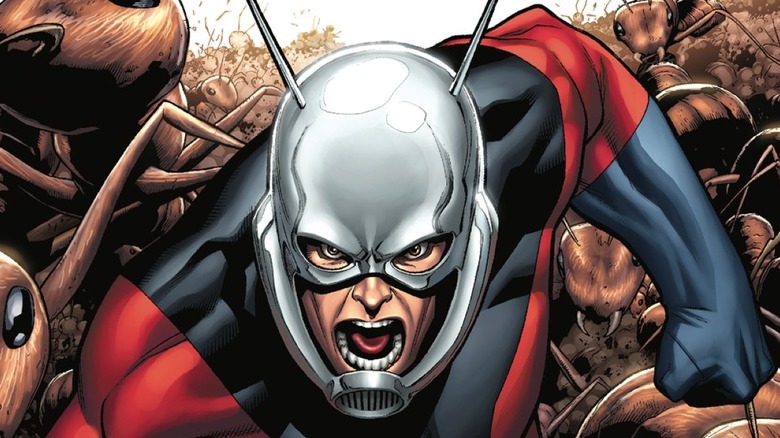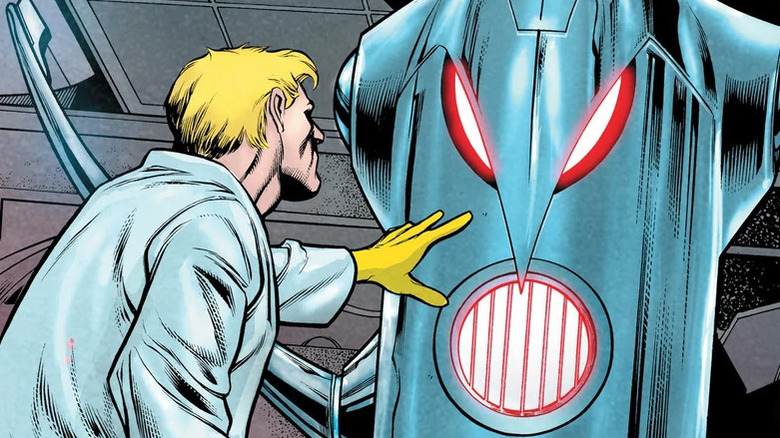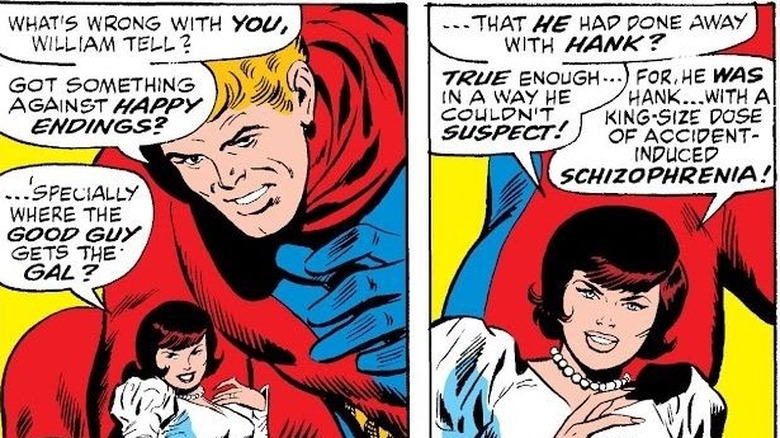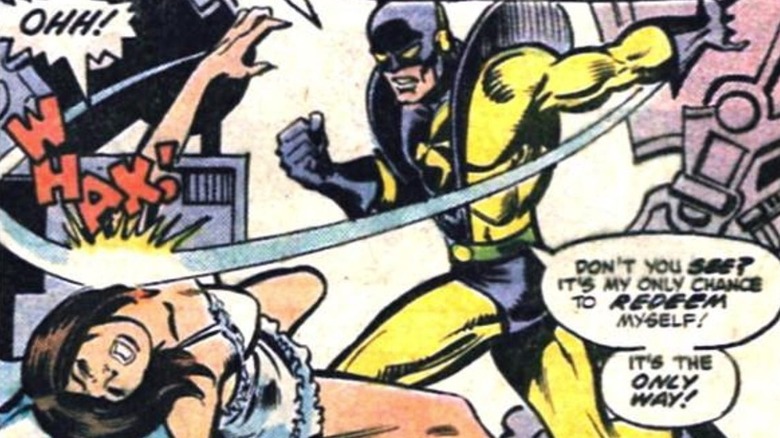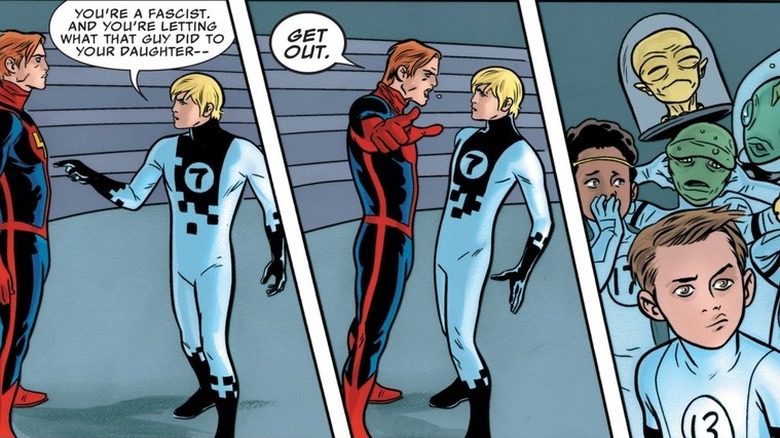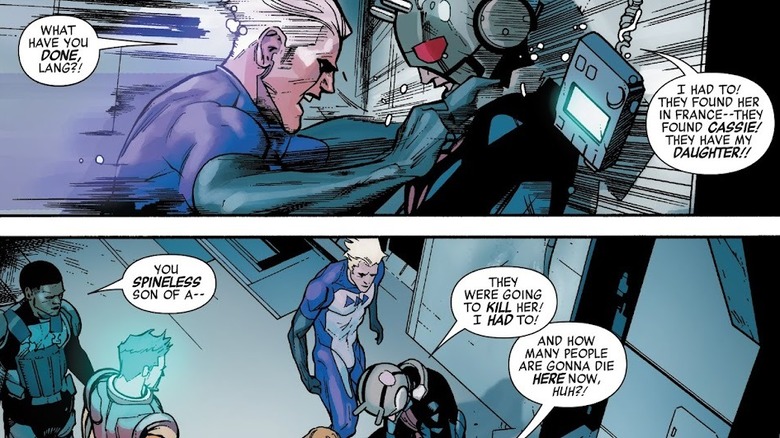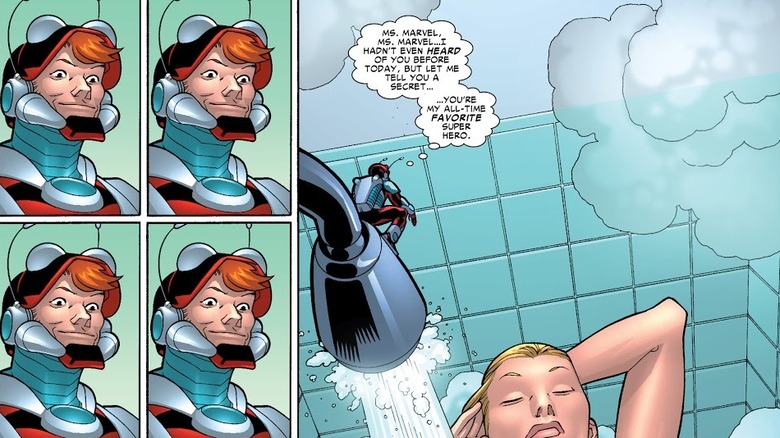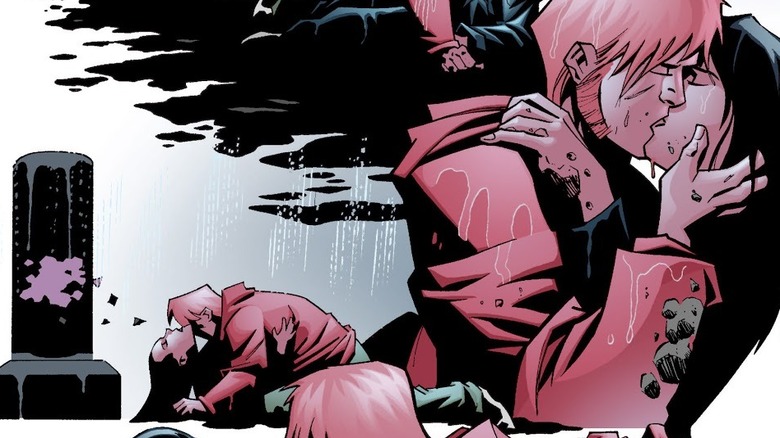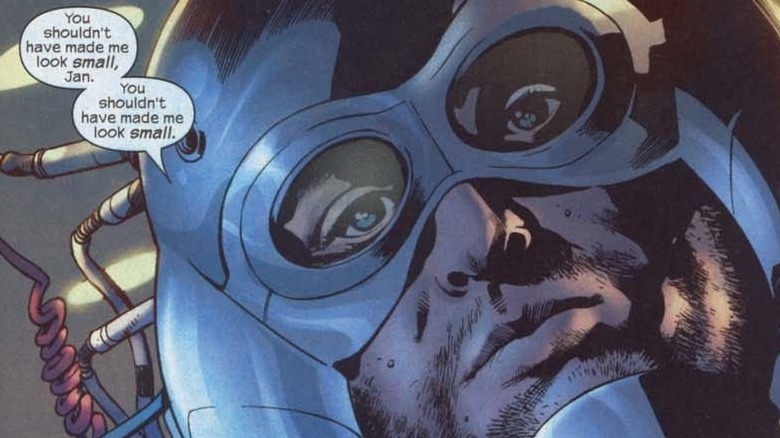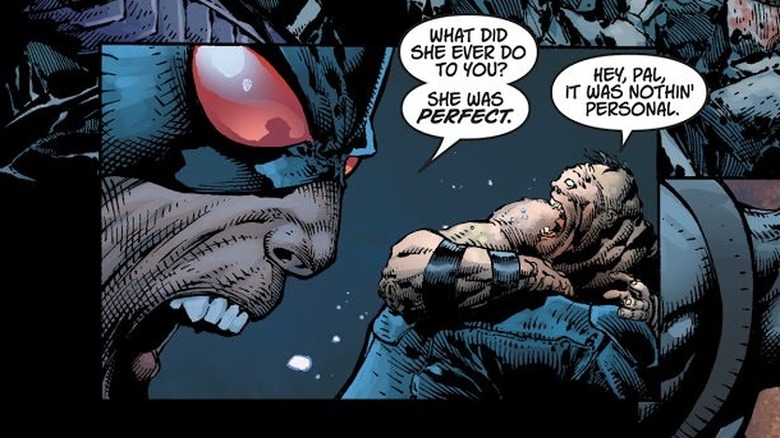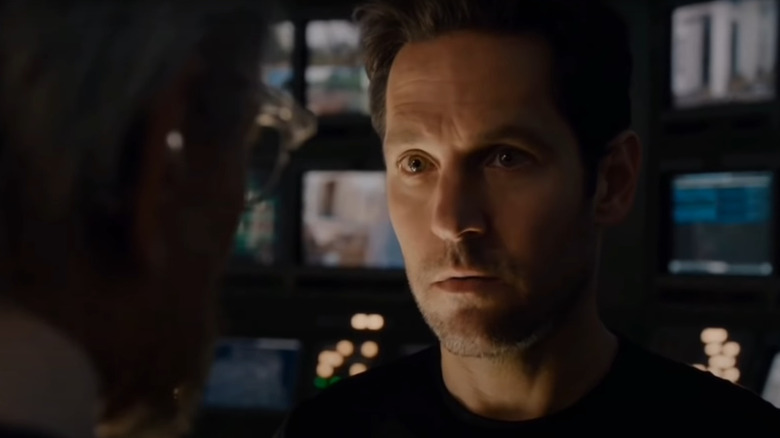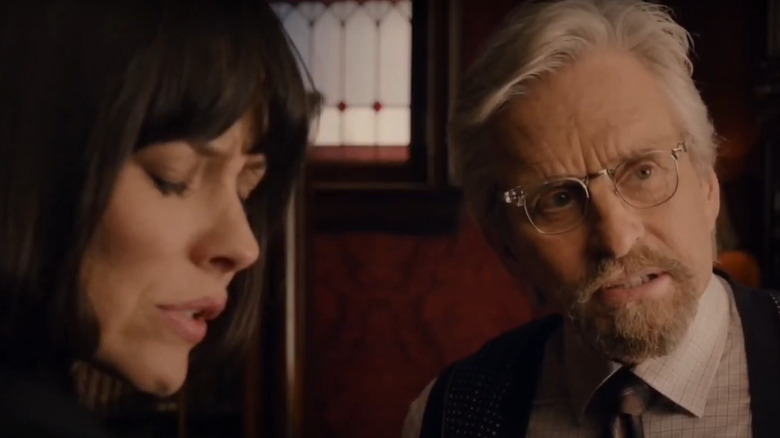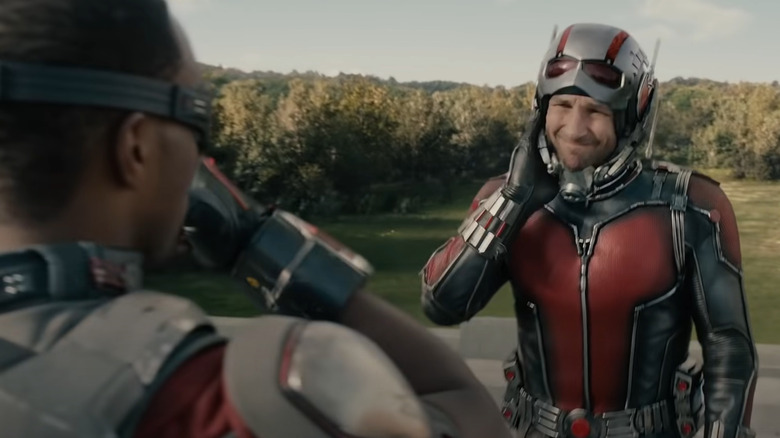Times Ant-Man Wasn't So Heroic
Prior to his debut appearance in a full-length feature film in 2015, Ant-Man's profile and popularity were as diminutive as his animal namesake — particularly when compared to his fellow Marvel superheroes. Considering the Pym Particle-powered protagonist's significance in his own universe, his pint-sized prominence was a bit of a conundrum. After all, not only was he one of the first heroes to become part of the 1960s Marvel superhero boom (debuting in 1962's "Tales to Astonish" #35), but he was also a founding member of the comic book company's premier super-team, the Avengers.
That said, a quick glance at Ant-Man's publication history reveals that his lackluster reputation among the spandex-clad set wasn't for Marvel's lack of trying. Over the decades, there have been multiple attempts to reinvent the superhero, including turning him into a legacy character. While many have donned the size-changing suit of the formicid-themed fighter, the most well-known are original suit creator Dr. Hank Pym, his "official" successor Scott Lang, and low-level S.H.I.E.L.D. operative Eric O'Grady.
Unfortunately, despite changing hands multiple times, the Ant-Man identity has proven to be particularly problematic, no matter who's under the helmet. The men who have assumed the mantle of Ant-Man all came with their own unique hang-ups and made less-than-heroic decisions, contributing to the detriment of an already tarnished superhero moniker. Here are some of the worst things Ant-Man has done, both in the comic book and cinematic realms.
Hank Pym created Ultron
In spite of his celebrated scientific brilliance and active role in saving the world numerous times, Dr. Hank Pym has had enough identity crises, self-destructive episodes, and questionable choices to fill an entire list on his own. Among all his = blunders over the years, however, few have had as serious a consequence as his unintentional creation of one of the worst evils the world has ever seen: the murderous A.I. known as Ultron.
In a way, Pym's greatest failing was also his greatest accomplishment. 1968's "Avengers" #58 reveals the origin of arguably the Avengers' greatest foe. Pym attempted to push the boundaries of robotics and artificial intelligence by creating a robot patterned after his own brain. As it turned out, Pym was a little too successful, as the robot gained sentience, learned how to switch itself on, and quickly developed a deep-set hatred for its creator. Taking Pym by surprise in his laboratory, Ultron wipes his memory of the events that transpired, enabling the robot to escape and plan the destruction of the Avengers.
Over the years, Pym's creation tangled with Earth's Mightiest Heroes many times, typically in a bid to dominate the planet and eradicate humanity. Still, perhaps the most frightening thing about Ultron — as Pym himself acknowledged in the "Avengers: Ultron Unlimited" story arc — is that the nigh-indestructible villain's thirst for destruction hints at a darkness in Pym's own mind.
Hank Pym kidnapped the Wasp, then married her
Throughout Pym's troubled history as a superhero, he has mostly relied on shedding heroic identities and taking on new ones as a means of making up for his past misdeeds while attempting to understand himself better. At various points in his career, he assumed the mantles of Ant-Man, Giant-Man, Goliath, and even the Wasp. His most controversial and dramatic identity shift, however, is perhaps his debut as Yellowjacket.
1968's "Avengers" #59 shows Pym sporting his brand-new Yellowjacket disguise and crashing what was supposed to be an Avengers meeting involving the Vision, the Black Panther, Hawkeye, and the Wasp (Janet van Dyne, Pym's girlfriend). In his black and yellow garb, the troubled adventurer boasts to his stunned audience that he had actually murdered Goliath, and that he wanted to replace the size-changing Avenger on their team. This encounter quickly goes awry, as the heroes are unable to stop Yellowjacket from knocking out and kidnapping the Wasp.
Initially attempting to find out if her boyfriend was still alive, van Dyne realizes that Yellowjacket was actually Pym, suffering from a chemically triggered bout of schizophrenia and legitimately believing that he had "killed" the Pym persona. To help him regain his senses, van Dyne agrees to marry him — and sure enough, Pym goes back to his former self after supervillains crash their wedding party. All of which is an excellent foundation on which to build a marriage.
Hank Pym faked an Avengers attack — and struck his wife
Even after marrying the love of his life, Pym's struggles continued. In 1981's "Avengers" #212, his erratic behavior reached the point where it deeply impacted his relationship with both his wife and his teammates. During his first meeting with the Avengers after returning to full-time active duty, Pym exhibits intense irritability, believing that Captain America and the rest of the team were belittling his abilities. While responding to an emergency situation, Pym continues to verbally abuse his wife, and ends up using excessive force against an opponent who nearly kills him in retaliation.
In the next issue, Captain America calls for Yellowjacket to be court-martialed due to his actions that almost resulted in a catastrophe. Pym does not take this well, and despite his wife's best efforts to cheer him up, he locks himself up in his laboratory for three days, concocting a scheme to help him get back into the Avengers' good graces. Worried, the Wasp sneaks into his lab and discovers the truth: Pym has constructed an adamantium robot, and plans to stage an attack on the Avengers so that he could "save" them and look like a hero. His wife attempts to stop him, resulting in a now-infamous panel of Pym slapping her.
Pym pushes through with his plan, but the robot turns on him. In the end, his wife saves him. Yellowjacket runs away from the mansion in shame, and the Wasp eventually divorces him.
Scott Lang tried to send kids to fight Doctor Doom
While seemingly more well-adjusted than his predecessor, former thief Scott Lang had his fair share of troubles as well. He initially became Ant-Man after stealing the suit from Pym in 1979's "Marvel Premiere" #47, but earned the scientist's trust and blessing soon after, eventually becoming a member of the Avengers himself.
Unfortunately, Lang's life came to a tragic (albeit temporary) end due to the machinations of the Scarlet Witch in 2004's "Avengers Disassembled" event. However, 2012's "Avengers: The Children's Crusade" retroactively rewrites this, revealing that instead of dying, Lang was actually transported to the future by his daughter Cassie (aka the Young Avenger Stature). In their subsequent battle against Doctor Doom, Cassie dies by the Latverian ruler's hand, leaving the newly-returned Lang grieving and thirsty for revenge.
Lang sees an opportunity to get back at Doom in 2013's "FF" #3. A time-displaced Johnny Storm from Earth-13266 appears before the Future Foundation, revealing that Doom killed the other members of the Fantastic Four on his world and enlisting their aid in stopping him. In the next issue, Lang decides to use all of the Future Foundation's members and resources to essentially murder Doom; it is worth noting that at this point, the FF's roster consisted mainly of children. While this plan never really comes to fruition, the fact that Lang even suggested sending child soldiers after a full-fledged supervillain is in itself an act of dubious judgment.
Scott Lang became a mole for Hydra
The 2017 event Secret Empire was a controversial comic book storyline, mainly due to its depiction of Captain America — or at least, an evil duplicate of Captain America — as a sleeper agent of Marvel's Nazi counterpart organization, Hydra. In this story, the Captain America doppelganger was able to manipulate the superhero community and maneuver himself into a position of power, allowing Hydra to (temporarily) take control of the United States. Unsurprisingly, the heroes who were able to elude Hydra's grasp formed a resistance unit (called, appropriately enough, the Underground) to try and take back the country. Unfortunately, they had no idea that a traitor was hiding in their midst.
In an attempt to keep his daughter Cassie safe from Hydra's clutches, Lang sends her to France to hide. However, Hydra still managed to find Ant-Man's daughter and capture her, giving them the leverage they needed to get Lang on their side. Fearing for Cassie's safety, Lang decides to turn on his allies by giving Hydra vital information about the resistance group's headquarters.
To Lang's credit, he quickly owns up to what he did, lending invaluable assistance to the Winter Soldier by providing him with the Pym Particles he needs to turn the tide against Hydra. The guilt Lang feels due to his actions, however, proves to be too much, so he attempts to leave Earth in "All-New Guardians of the Galaxy" Vol. 1 #12.
Eric O'Grady used his Ant-Man powers for thievery and perversion
An otherwise insignificant government operative with dubious morals, S.H.I.E.L.D. agent Eric O'Grady is perhaps one of the least likely candidates to be a superhero in the entire Marvel Universe. In fact, he wasn't actually even supposed to be the next "official" Ant-Man in the first place, as it was initially in the possession of his fellow agent Chris McCarthy. Unfortunately, due to tragic events resulting from O'Grady's selfishness, McCarthy died in the line of duty — and in an attempt to save his own skin, his so-called friend shamelessly took the Pym particle-powered suit from McCarthy's fresh corpse.
In "Irredeemable Ant-Man" Vol. 1 #2, O'Grady and McCarthy (stuck in a new version of the Ant-Man suit) find themselves trapped in the S.H.I.E.L.D. Helicarrier as a group of villains tries to take it down. In the ensuing crossfire, O'Grady pushes his friend into harm's way as he scrambles to open a locked door, resulting in McCarthy sustaining a lethal head wound. Panicking, O'Grady pulls the Ant-Man suit off his friend's body and wears it, using its shrinking powers to save himself from certain death.
For the rest of the series, O'Grady dons the suit and takes advantage of its features for ... less-than-heroic deeds, including using its ant communication capabilities for his amusement, stealing jewels from a thief, and spying on various women (including Carol Danvers, aka Ms. Marvel/Captain Marvel) in the shower.
Eric O'Grady impregnated his dead best friend's girlfriend, then left her
Although O'Grady learned (very, very slowly) how to be a hero over the course of his career, he certainly pulled off some despicable deeds during his early days. However, most of them could be considered mere blunders and missteps compared to this one: Right after his friend Chris McCarthy's funeral — the same friend whose death O'Grady caused — the new Ant-Man attempted to have sex with McCarthy's girlfriend Veronica King ... right on top of his grave.
In "Irredeemable Ant-Man" Vol. 1 #3, O'Grady and King find themselves in a moment of vulnerability, due to their shared grief over McCarthy's passing. Overcome by intense emotion, they briefly give in to their impulses, and almost end up making love beside McCarthy's tombstone under the rain. King is able to stop herself, and leaves O'Grady half-naked and confused in the mud. However, the pair do end up sleeping together in the next issue.
By the conclusion of the series, King drops a bombshell on O'Grady: She's pregnant with his child. In a moment that was perhaps prompted by both self-reflection and selfishness, O'Grady rejects her, saying that he doesn't love her and he would be a terrible father (though he does commit to paying child support).
Ultimate Hank Pym nearly killed his wife, then betrayed his country
Launched in 2000, Ultimate Marvel reimagined the origins of Marvel superheroes by depicting how they would turn out if they were created in that decade instead of the '60s. Many of the Ultimate versions of classic Marvel characters retained key traits that linked them to their mainstream counterparts. Unfortunately, for Ultimate Hank Pym, it meant that he shared the same troublesome behavior and abusive tendencies as the original, but dialed up to 11.
Like their Earth-616 versions, Ultimate Pym and Janet were in an intimate relationship, and were both members of Earth's premier super-team (called the Ultimates in this reality). However, the inherent darkness in Pym's soul manifested to a terrifying degree in 2002's "Ultimates" #6. Overcome by self-doubt and jealousy, Pym takes an argument with his partner too far, siccing ants and using insect spray on her while she was in miniature form. As Janet recovers in a hospital, Captain America decides to teach the abusive spouse a lesson in physical pain and expel him from the Ultimates.
Driven to his lowest low, Pym turns traitor, choosing to aid the Liberators, an invading team of super-powered fighters, in taking over the United States. As 2006's "Ultimates 2" #10 depicts, Pym creates an entire army of Ultron enforcers to help the Liberators conquer America. However, as soon as the Ultimates start winning the fight, the disgraced scientist switches sides, claiming it was his plan all along.
Ultimate Hank Pym bit off the Blob's head
A mainstay in most "worst comic book storylines" lists, 2009's "Ultimatum" was perceived by many comic book readers as Marvel's way of tidying up the increasingly cluttered continuity of the Ultimate Universe. The series featured some of the most gruesome deaths of Marvel characters ever depicted in full-color panels — including a brutal display of cannibalism from not just one, but two characters in a single issue.
In "Ultimatum" #3, Pym and Hawkeye discover, to their horror, the mutant supervillain the Blob snacking on the remains of Pym's estranged wife, the Wasp. Blinded by murderous rage, Pym increases in size, picks up the otherwise "unmovable" Blob, and violently bites off the head of Magneto's corpulent crony.
In his grief, Pym takes what was left of his dead wife and heads off to the Triskelion, planning to trigger a secret initiative called "The Jocasta Project" in the hopes of reviving the fallen Ultimate. Upon reaching the building, Pym entrusts this task to Iron Man, and sacrifices himself by taking all of the evil mutant Multiple Man's bomb-strapped duplicates with him into the water before they could blow up the Triskelion.
MCU Scott Lang started stealing again after being released from prison
In the MCU, Scott Lang's role as Ant-Man is anything but insignificant. After all, his unexpected return did prove to be pivotal in bringing half the universe back to life in 2019's "Avengers: Endgame." That said, it's easy to forget that Lang's career as the size-changing superhero didn't exactly start out smoothly. In fact, one could say that he kind of got manipulated into it — but partly because of his own decisions.
As seen in 2015's "Ant-Man," Lang (Paul Rudd) attempts to turn a new leaf right after he was released from jail. Unfortunately, his standing record prevents him from getting any sort of stable, long-term work. Out of options and desperate to make a living, Lang decides to join his best friend Luis' team of thieves to pull off a quick robbery. As it turns out, their target is the home of scientist and former S.H.I.E.L.D. consultant Dr. Hank Pym (Michael Douglas) — and the item Lang is tasked to steal is Pym's long-mothballed Ant-Man suit.
It is quickly revealed that the entire heist was actually orchestrated by Pym himself to find the best candidate to be the new Ant-Man. He instructs Lang to put on the suit, begins training him to use its powers, and gives him a new mission: Break into Pym Technologies (rebranded as Cross Technologies) and steal the experimental Yellowjacket suit before it falls into the wrong hands.
MCU Scott Lang ruined a father-daughter reconciliation
In most of his appearances in the MCU, Lang has generally been a reliable team player, and has proven his worth as a superhero in the face of seemingly insurmountable odds. As he was committed to turning his life around after finishing his prison term, he was also careful (for the most part) about the decisions he made. That said, Lang's hilariously bad timing once ruined what should have been a tender moment of forgiveness and healing between a father and his daughter.
As "Ant-Man" reveals, Hope van Dyne (Evangeline Lilly) kept a decades-long grudge in her heart against Pym, her father, due to the disappearance and presumed death of her mother. When Pym explains the truth behind what happened to his wife — an act of self-sacrifice during a critical mission — Hope finds it in her heart to begin forgiving her father ... until Lang completely destroys the mood with some unnecessary commentary about the beauty of the moment. Immediately earning the ire and disappointment of Pym and Hope, Lang realizes his comical faux pas, and hurriedly shuffles off to make tea.
MCU Scott Lang fought and endangered the life of an Avenger
When Lang first donned Pym's Ant-Man's suit in "Ant-Man," his expectations were set when the scientist told him what his mission was. What he probably wasn't expecting, though, was that he would soon come face to face with an Avenger: none other than the high-flying government operative and future Captain America, Sam Wilson aka the Falcon (Anthony Mackie).
As part of the mission, Lang had to break into the Avengers' training grounds. Unsurprisingly, the fledgling superhero was quickly identified as an intruder, prompting the winged Avenger to swoop in and investigate. Despite being quite new to the superpowered world, Ant-Man does manage to put up a fight against the Falcon, albeit briefly. However, Lang gets the upper hand when he sabotages the Falcon's flight gear from the inside, causing the Avenger's wings to malfunction and bringing him tumbling to the ground. It's worth noting that if this incident took place from a much higher altitude, there's a good chance that Lang could have killed the Falcon, completely altering the landscape of the MCU for years to come. Hmm ... now, wouldn't that make for an interesting "What If?" episode?
